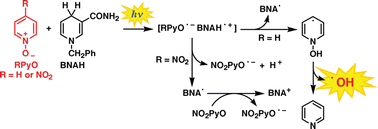Hydroxyl radical generation via photoreduction of a simple pyridine N-oxide by an NADH analogue†
Abstract
Photoreduction of

Maintenance work is planned for Wednesday 1st May 2024 from 9:00am to 11:00am (BST).
During this time, the performance of our website may be affected - searches may run slowly and some pages may be temporarily unavailable. If this happens, please try refreshing your web browser or try waiting two to three minutes before trying again.
We apologise for any inconvenience this might cause and thank you for your patience.
* Corresponding authors
a
Redox Regulation Research Group, Research Center for Radiation Safety, National Institute of Radiological Sciences (NIRS), Inage-ku, Chiba, Japan
E-mail:
nakanis@nirs.go.jp
Fax: +81 43 255 6819
Tel: +81 43 206 3131
b
Department of Material and Life Science, Graduate School of Engineering, Osaka University, SORST, Japan Science and Technology Agency (JST), Suita, Osaka, Japan
E-mail:
fukuzumi@chem.eng.osaka-u.ac.jp
Fax: +81 6 6879 7370
Tel: +81 6 6879 7368
c Department of Toxicology and Environmental Health, Graduate School of Pharmaceutical Science, Chiba University, Chuo-ku, Chiba, Japan
d Faculty of Pharmaceutical Sciences, Sojo University, Ikeda, Kumamoto, Japan
e Department of Chemistry and Biology, University of Virginia, Charlottesville, Virginia, USA
f
Division of Organic Chemistry, National Institute of Health Sciences (NIHS), Setagaya-ku, Tokyo, Japan
E-mail:
fukuhara@nihs.go.jp
Fax: +81 3 3707 6950
Tel: +81 3 3700 1141
g Graduate School of Pharmaceutical Sciences, Nagoya City University, Mizuho-ku, Nagoya, Aichi, Japan
Photoreduction of

 Please wait while we load your content...
Something went wrong. Try again?
Please wait while we load your content...
Something went wrong. Try again?
I. Nakanishi, C. Nishizawa, K. Ohkubo, K. Takeshita, K. T. Suzuki, T. Ozawa, S. M. Hecht, M. Tanno, S. Sueyoshi, N. Miyata, H. Okuda, S. Fukuzumi, N. Ikota and K. Fukuhara, Org. Biomol. Chem., 2005, 3, 3263 DOI: 10.1039/B509447J
To request permission to reproduce material from this article, please go to the Copyright Clearance Center request page.
If you are an author contributing to an RSC publication, you do not need to request permission provided correct acknowledgement is given.
If you are the author of this article, you do not need to request permission to reproduce figures and diagrams provided correct acknowledgement is given. If you want to reproduce the whole article in a third-party publication (excluding your thesis/dissertation for which permission is not required) please go to the Copyright Clearance Center request page.
Read more about how to correctly acknowledge RSC content.
 Fetching data from CrossRef.
Fetching data from CrossRef.
This may take some time to load.
Loading related content
